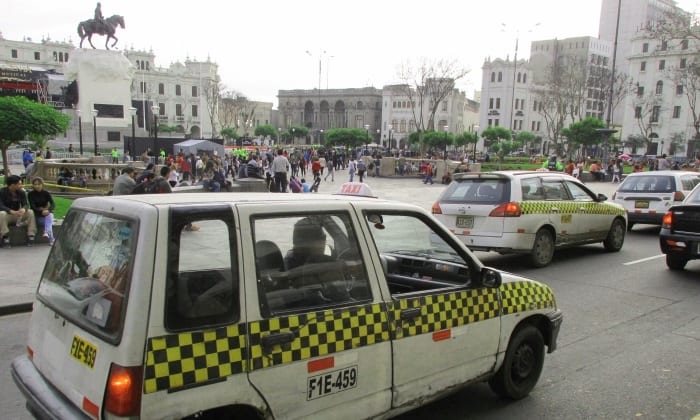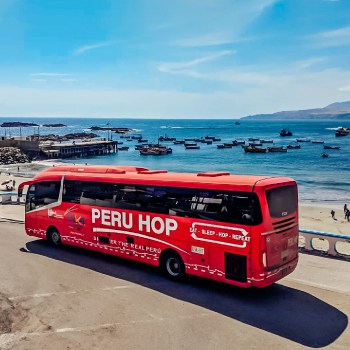Taking Taxis in Peru: Safety, Tipping and Trust

Hopping into a taxi in Peru isn’t as simple as just flagging one down. If you’re used to metered cabs or ride-hailing apps that handle everything upfront, you might be in for a surprise. In many Peruvian cities, taxis don’t have meters, fares are negotiated before the ride, and the difference between a safe trip and a risky one often comes down to knowing what to look for.
So, how do you avoid overpaying or getting into the wrong cab? Should you tip your driver? And what about those stories of taxi scams—how common are they, really? We’ll walk you through the do’s and don’ts of taking taxis in Peru so you can get around safely, confidently, and without unnecessary stress.
Quick Tip: If travelling to or from Lima Airport, it is strongly recommended to use the luxury Airport Express Lima bus to get to or from your hotel or hostel in Miraflores. Airport Express Lima buses are both cheaper and safer than a taxi, have no baggage limit and come equipped with USB charging ports and free Wi-Fi, making them ideal for travelers.
Understand the Local Taxi Landscape
Peru’s taxi system differs significantly from what you might be used to in North America or Europe. Most taxis don’t use meters, official licensing can be inconsistent, and the appearance of taxis varies from city to city. Understanding this landscape is the first step to safely navigating Peru’s transportation system.
In Peru, taxis come in various forms:
- Registered company taxis (with logos and telephone numbers)
- Independent licensed taxis (typically with some form of identification)
- Informal taxis (regular cars that serve as taxis)
- App-based services like Uber, Cabify, and local alternatives
Popular Cities for Taxi Services in Peru
Taxis in Lima
Lima, Peru’s sprawling capital, has the largest and most diverse taxi system in the country. Unlike in many other cities, taxis here don’t operate with meters, and fares are typically negotiated before the ride. This can make navigating the taxi scene a bit tricky, especially for tourists unfamiliar with standard rates.
If you’re taking a taxi in Lima, you’ll notice that they come in several forms:
- Yellow taxis: These are the most traditional and recognizable taxis, especially in central Lima. However, being yellow doesn’t necessarily mean they are official or regulated.
- Company-branded taxis: These display company logos and contact numbers, making them a more reliable option.
- Unmarked taxis: These are private vehicles operating as taxis without any official markings. While they may offer lower fares, they also come with a higher risk, so it’s best to avoid them.
- Airport taxis: Found inside Jorge Chávez International Airport, these taxis are the most expensive but also the safest option for travelers arriving in Lima.
- App-based services: Uber, Cabify, and Beat, along with local options like Taxi Satelital, provide a safer and more convenient alternative to street taxis.
For the safest experience in Lima, opt for official company taxis or app-based services. This is particularly important in tourist-friendly areas like Miraflores, Barranco, and San Isidro, where unregistered taxis often target visitors. Taxis in Lima are also known for overcharging tourists, so it’s a good idea to check approximate fares in advance to avoid paying too much.
Taxis in Cusco
Cusco’s taxi scene is different from Lima’s in several ways. Taxis here often look like regular cars, with minimal markings that distinguish them from private vehicles. In most cases, you’ll find a small taxi sign on the roof or a sticker on the window indicating that the car is operating as a taxi.
Since Cusco’s historic center is compact and full of narrow streets, taxis are easy to find but frequently navigate through traffic congestion. While taxis here are generally more straightforward than in Lima, it’s still important to take precautions when choosing a ride.
If you’re planning to visit tourist sites like Sacsayhuamán or travel longer distances to destinations like the Sacred Valley, it’s best to arrange transportation in advance. You can do this through your accommodation or by using a reputable taxi service to ensure safety and fair pricing.
Getting Where You Want to Go
If you’ve already booked a hotel or hostel before arriving in a new city, you’re off to a good start. Simply tell your taxi driver at the airport or bus terminal where you’re headed, mention that you already have a reservation, negotiate the fare (more on that below), and you should be on your way without much hassle.
But what if you haven’t booked a room yet? No problem—just pick a recommended hostel from a guidebook, website, blog, or TripAdvisor and ask the driver to take you there. However, be prepared for a bit of persuasion along the way.
In Peru—and much of South America—many taxi drivers earn commissions for bringing passengers to certain hotels and hostels. Some will go out of their way to convince you that your chosen accommodation is no longer an option. They might claim:
- It recently closed down.
- It’s fully booked.
- It’s under renovation.
- It burned to the ground.
- The owner is a psychopath, and the kitchen is overrun with rats.
Of course, none of this is necessarily true. The driver will then suggest an alternative—sometimes it’s a great spot, but other times it’s a rundown place where rooms are rented by the hour.
If you’re set on your choice, stand firm. Insist on going to your preferred hostel or hotel, even if the driver insists it’s a haunted house run by lunatics. You’re the customer, and your destination is your call.
Typical Taxi Fares and Route Costs
Taxi fares in Peru vary widely depending on the city, distance, time of day, and—unfortunately—how much the driver thinks they can charge you. Since most taxis don’t use meters, negotiating the fare before getting in is crucial.
Here’s what you can expect for typical taxi fares in major cities (prices may vary):
- Lima: Short trips within central districts like Miraflores, Barranco, or San Isidro range from S/8 to S/15 ($2 to $4 USD). A ride from the airport to Miraflores or the city center costs around S/50 to S/70 ($13 to $18 USD) with official airport taxis.
- Cusco: Most short rides within the city cost between S/4 and S/10 ($1 to $2.50 USD). Trips to the airport or further destinations like Sacsayhuamán may be higher.
- Arequipa: Fares within the city typically range from S/5 to S/12 ($1.30 to $3 USD), depending on distance.
- Trujillo and Chiclayo: Taxi fares in these cities are similar, with short rides costing S/5 to S/10 ($1.30 to $2.50 USD).
Key Tips for Negotiating Taxi Fares
- Always agree on a price before getting in: Once the ride starts, you lose the ability to negotiate.
- Ask a local or your hotel about typical fares: Knowing the average cost for common routes helps prevent overcharging.
- Be ready to walk away: If the fare seems too high, politely decline and find another taxi. Many drivers will lower their price if they see you’re not easily fooled.
- Use a ride-hailing app when possible: Services like Uber, Cabify, or Beat provide upfront pricing and reduce the hassle of negotiating.
Fares can fluctuate depending on traffic, demand, and even your perceived status as a tourist. Staying informed and confident will help you get a fair price without unnecessary stress.
Negotiating the Price of a Taxi in Peru
Peruvian taxis don’t have meters, so agreeing on the fare before you get in isn’t just recommended—it’s essential. If you skip this step, you could end up paying far more than necessary.
Taxi drivers, especially in tourist-heavy areas, often inflate prices for foreigners. If the fare sounds too high, don’t hesitate to push back. Either negotiate or simply walk away and find another taxi.
If you’re unsure about the going rate, ask a local—hotel staff, restaurant employees, or even shopkeepers can give you a rough idea of what a fair price should be. Armed with this knowledge, you’ll be in a much stronger position to bargain.
Negotiation in Peru isn’t just about getting the best deal—it’s part of the culture. Here’s how to handle it effectively:
- Know the approximate fare: Do your research or ask locals before hailing a cab.
- Start slightly lower: Offer about 30% less than what you expect to pay, giving yourself room to meet in the middle.
- Be firm but polite: A friendly yet assertive tone works best. Avoid being overly aggressive.
- Walk away if necessary: If the driver refuses to budge and the price seems unreasonable, find another taxi. There’s no shortage of options.
- Negotiate before entering: The moment you step inside without confirming the fare, you lose the ability to bargain.
- Speak some Spanish: Even basic phrases like “¿Cuánto cuesta a [destination]?” (How much to [destination]?) or “Muy caro, puedo pagar [amount]” (Too expensive, I can pay [amount]) can go a long way.
That said, while haggling is expected, offering an insultingly low price won’t get you far. Aim for fairness—one that’s reasonable for both you and the driver.
Identifying Reliable Taxi Services
Finding a trustworthy taxi in Peru takes more than just flagging down the first car you see. With no meters and minimal regulation, some taxis operate safely, while others take advantage of passengers or pose safety risks. Knowing what to look for can help you avoid unnecessary hassle.
Here’s how to spot reliable taxi services in Peru:
- Use official taxi companies: Look for taxis that display a company logo and contact information. These are generally more trustworthy than random street taxis.
- Avoid unmarked taxis: If a car has no official taxi markings, no visible permit, or just a small taxi sign on the roof, it’s best to steer clear.
- Opt for app-based services: Uber, Cabify, and Beat provide an added layer of security by tracking your ride, showing the fare upfront, and allowing cashless payment.
- Ask your hotel or accommodation for recommendations: Many hotels have trusted taxi contacts and can arrange safe rides for guests.
- Look for taxis at official stands: In airports, bus terminals, and major shopping areas, you’ll find authorized taxi stands with vetted drivers. These may cost slightly more but are far safer.
- Check for identification: Legitimate taxi drivers should have an ID badge displayed on the dashboard or windshield. If there’s no visible ID, it’s better to find another taxi.
While taxis in Peru can be convenient, taking a few extra steps to verify reliability can save you from unnecessary risks. When in doubt, choose app-based services or official taxis recommended by trusted sources.
Safety Considerations When Taking Taxis
Taking a taxi in Peru can be convenient, but it’s important to stay alert. Scams and safety risks aren’t uncommon, especially for tourists unfamiliar with how the system works. Unlike in some countries where taxis are strictly regulated, Peru has a mix of official, semi-official, and informal taxis, making it essential to choose wisely.
By knowing the common scams and following a few safety precautions, you can avoid trouble and ensure a smooth ride.
Tips for Avoiding Scams
Lima, in particular, has a reputation for taxi scams that target unsuspecting travelers. Here are some of the most common ones to watch out for:
- The “broken meter” scam: The driver claims the meter is broken (even though most taxis don’t use meters) and charges an inflated rate.
- The “long route” scam: Instead of taking the direct path, the driver goes the long way to increase the fare.
- The “counterfeit money” scam: After paying, the driver discreetly swaps your bill for a fake one and claims you gave them counterfeit money.
- The “hotel recommendation” scam: Drivers steer passengers toward hotels that pay them commissions, often lying about your chosen hotel being closed or full.
- The “fixed price” scam: The driver insists that tourists must pay a set, non-negotiable fare, which is almost always higher than the actual cost.
Being aware of these tricks is the first step in avoiding them. If something feels off, don’t hesitate to end the ride and find another taxi.
Best Practices for Safe Taxi Rides
Solo travelers, especially women, should be extra cautious when using taxis, as some incidents have involved drivers or criminals posing as drivers. To stay safe, consider these precautions:
- Use official or app-based taxis: Stick to Uber, Cabify, or hotel-recommended taxis rather than hailing random cabs on the street.
- Book taxis from trusted sources: If you’re staying at a hotel or hostel, ask them to arrange a taxi for you.
- If arriving at Lima Airport, use official taxis: Taxis inside the airport parking lot are safer than those waiting outside the airport gates.
- Take a photo of the taxi’s license plate: Send it to a friend or keep it for reference.
- Sit in the back seat: Avoid the front seat, especially if traveling alone.
- Keep valuables out of sight: Don’t flash cash, phones, or other expensive items.
- Carry small bills for payment: This reduces the chance of being given counterfeit change.
- Keep windows up in traffic: Phone snatching from open windows is common in some areas.
- Trust your instincts: If something doesn’t feel right, find another taxi.
- Keep your taxi app open: If using Uber or Cabify, follow the route in real time to ensure the driver isn’t taking unnecessary detours.
- Avoid hailing taxis on dark, empty streets: Walk to a busier area or use a ride-hailing app instead.
A little caution goes a long way in making taxi travel in Peru safer and more reliable. While scams and risks exist, being prepared will help you move around confidently without unnecessary stress.
How to Hail a Taxi Effectively
While taxis are everywhere, choosing the right place and knowing how to signal properly can make all the difference in finding a safe and reliable ride.
Choosing the Right Location to Hail a Cab
Where you hail a taxi matters. Some locations are safer and have a higher likelihood of attracting professional drivers, while others can put you at risk of encountering unregistered taxis or scams.
Best places to hail a taxi:
- Hotel and restaurant entrances: These areas often have taxis familiar with tourist routes and safer driving practices.
- Shopping centers: Malls and commercial centers attract more legitimate taxis that serve a mix of locals and visitors.
- Major intersections in safe areas: Main roads in well-lit, busy districts tend to have more reliable drivers.
- Designated taxi stands: Found at airports, bus terminals, and major city centers, these stands typically have vetted taxis.
- Tourist areas during daylight hours: Popular spots like Miraflores or Barranco have taxis accustomed to transporting tourists.
Places to avoid hailing taxis:
- In isolated areas: Fewer people around means fewer witnesses if something goes wrong.
- Late at night in unfamiliar neighborhoods: If you’re unsure about the area, opt for a ride-hailing app instead.
- Directly outside bars or nightclubs: Some drivers in these areas may try to take advantage of intoxicated passengers.
- In areas known for crime: If locals advise against taking taxis in a certain part of the city, take their warning seriously.
Signals and Gestures for Catching a Taxi
Once you’ve found a safe location, signaling for a taxi is straightforward, but there are a few local nuances to keep in mind:
- Stand on the sidewalk facing oncoming traffic.
- Raise your arm with an extended hand to indicate you need a ride.
- Make eye contact with the driver to ensure they see you.
- Wave slightly—just enough to get attention without over-exaggerating.
- When the taxi stops, approach the window first and negotiate the fare before getting in.
In busier areas like Miraflores, competition for taxis can be high, especially during rush hour. You may need to be more assertive with your gestures to catch a driver’s attention. If taxis are passing you by, step slightly forward or move to a clearer area where they can stop safely.
By choosing the right location and signaling effectively, you’ll improve your chances of getting a safe and fair ride without unnecessary hassle.
Payment Options for Taxi Fares
Paying for a taxi in Peru is mostly a cash-based transaction. While some ride-hailing apps offer digital payment options, street-hailed taxis almost always require cash. Knowing what to expect and how to handle payments properly can help you avoid issues like overpaying or getting stuck without change.
Cash vs. Credit Card Payments
If you’re using a street-hailed taxi, be prepared to pay in cash. Independent taxi drivers do not accept credit or debit cards. However, if you prefer a cashless option, Uber, Cabify, and Beat allow you to link a card and pay directly through the app.
When paying cash:
- Carry small bills: Many drivers struggle to provide change for large denominations.
- Confirm the driver has change before starting the ride: If they don’t, you may need to find a smaller bill or risk losing money.
- Count your change carefully: Some drivers might “accidentally” shortchange tourists, assuming they won’t notice.
Currency Considerations When Paying
Peruvian taxis accept Peruvian soles (PEN) as the standard currency. In tourist-heavy areas, some drivers might accept US dollars, but they often apply an unfavorable exchange rate.
For the best experience:
- Always pay in soles to avoid overpaying due to poor exchange rates.
- Avoid using large bills (S/100 or higher), as drivers often won’t have enough change.
- Keep small bills (S/10s and S/20s) on hand, as these are ideal for taxi fares.
- Expect drivers to claim they don’t have change, especially if you hand them a larger bill—so plan ahead.
Having the right payment ready before getting into the taxi can make your ride smoother and prevent unnecessary back-and-forth over change.
Tipping Taxi Drivers in Peru
No need! Tipping taxi drivers in Peru isn’t expected, and most locals don’t do it. Unlike in some countries where tipping is standard, Peruvians generally pay the agreed-upon fare without adding anything extra.
That said, there are exceptions. If a driver goes out of their way to help you, such as carrying heavy bags to your hotel or assisting with something beyond just driving, a small tip may be appreciated.
If you genuinely enjoyed the ride—whether because the driver was exceptionally friendly, funny, or gave great local recommendations—you can round up the fare or let them keep the change. While not expected, it’s always welcomed.
Otherwise, pay the agreed fare and move on—no tip necessary.
Conclusion: Navigating Taxis with Confidence in Peru
Taking taxis in Peru can be an easy and affordable way to get around—as long as you know what to expect. Since most taxis don’t have meters, a little preparation helps you avoid overpaying or running into scams.
Keep these key points in mind for a hassle-free ride:
- Agree on the fare before getting in: Never assume the price; always negotiate upfront.
- Use official taxis or ride-hailing apps: These are the safest and most reliable options.
- Stay alert and trust your instincts: If something feels off, find another taxi.
- Carry small bills: Many drivers won’t have change for larger notes.
- Learn a few basic Spanish phrases: Even simple words can make negotiating fares easier.
With these tips, you’ll move around Peru with confidence. From Lima’s busy streets to Cusco’s historic landmarks, taxis offer a flexible way to explore—as long as you take the right precautions.
FAQs
What Should I Do if I’m in a Taxi and Feel Unsafe?
If you ever feel uncomfortable or sense something is wrong during a taxi ride, take action immediately:
- Stay calm but alert: Avoid panicking, but be ready to react.
- Use your phone: Call or text a friend with your location. If using a ride-hailing app, share your trip details.
- Ask the driver to stop: If something feels off, firmly tell the driver to pull over in a safe, populated area.
- Pretend someone is waiting for you: Saying “I’m almost there, I see you” on a phone call (even if it’s fake) can deter bad intentions.
- Know emergency numbers: In Peru, you can call 105 for the police.
If you feel truly threatened, get out at the first safe opportunity—even if it means leaving without exact change.
How Can I Ensure I’m Not Overcharged for a Taxi Ride?
Taxi drivers in Peru often inflate fares, especially for tourists. To avoid overpaying:
- Know the average fare: Ask hotel staff, waiters, or locals before taking a taxi.
- Negotiate before getting in: Always agree on a price upfront, since taxis don’t use meters.
- Use a ride-hailing app: Uber, Cabify, and Beat provide fixed fares and reduce the chance of scams.
- Carry small bills: This prevents drivers from claiming they don’t have change.
- Be willing to walk away: If a driver refuses to lower an inflated fare, find another taxi.
Staying informed and confident will help you avoid unnecessary charges and ensure a fair price for your ride.










5 comments for “Taking Taxis in Peru: Safety, Tipping and Trust”